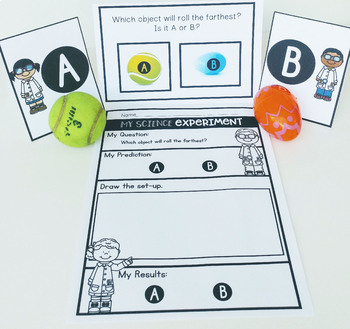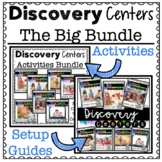Kindergarten Science Center Bundle, Choice Time Science Activities, Play Based
- Zip
What educators are saying
Products in this Bundle (5)
Also included in
- If you are looking to setup developmental centers, such as blocks, story, math, writing, STEM, science, or art, in your preschool, kindergarten, or first grade classroom, this resource has everything you need to get started. It includes a set of 7 setup guides (one for each center) that will walk yoPrice $62.00Original Price $122.00Save $60.00
Description
These science center activities are my favorite ways to encourage scientific thinking and practices in my kindergarten classroom, but can also be used in preschool, first grade or homeschool. Use these fun science centers as an independent activity, investigation station, science tubs, morning work, choice time or for small group lessons. Each science center can easily extend whole and small group science lessons and are great play based alternatives to worksheets. Just add a few easy-to- find, hands-on items, and you are ready to go!
Young children are natural scientists who love to ask questions, explore, and experiment. Each science activity was selected based on my own experience of teaching science and observing young children, as they worked and played in the science center during choice time.
Read Science Center Activities Your Kiddos Will Love to see these ideas in action.
✅These Science Center Activities Include:
- Creature Features: An animal research activity that helps children notice and compare the body features of a variety of animals.
- Fab Lab Experiments: Simple experiments presented in a consistent format that support children in designing and carrying out their own experiments.
- Cool Collections: Collections of objects for children to explore, observe and compare properties and use the science practices of sorting, counting, and measuring.
- Take-Apart Tub: An opportunity for children to learn how both living and nonliving things work by taking things apart.
⭐Bonus!
This bundle also includes a Science Center Classroom Set Up Guide that shows you how to set up, organize and maintain your classroom science center for use during independent practice and choice time.
✅What's Inside Each Science Center Activity?:
- Full-Color Task Cards to place at your center
- Kinder-Friendly Recording Sheets
- Sorting Mats (Cool Collections)
- Science Question Prompts
✅How Can I Use These Science Center Activities?:
There are many ways to use these science centers. You might try:
- Science Tubs
- Investigation Stations
- Science Centers
- Choice Time
- Free Play
- Small Group Lessons
- Whole Group Lessons
- Early Finisher Task
✅Which Science Skills Will We Practice?
- Asking Questions
- Planning and Carrying Out Investigations
- Observing, Comparing, and Contrasting
- Sorting and Classifying
- Communication Through Drawing, Writing, Speaking
✅Looking for More Kindergarten Center Activities?
- Math Center Invitations
- Makerspace Invitations
- Block Center Invitations
- Storytelling Invitations
- Writing Center Invitations
- Art Center Invitations
✅What Teachers Say About This Science Center Activities Bundle:
❤️"Absolutely love this bundle and how it's helped me create a science area that's less restrictive and more exploratory. Thank you so much!" Nicole H.
❤️"Great product for teachers who teach students with ASD, ADHD and ODD. These kids require a lot of choice, and this product allows them to take ownership of their learning." Laura H.
❤️"This is such a great resource to help get you started and offers so many wonderful ideas to maintain this centre. I also really love how student centred it is and the format of these type of centres!" Cheyenne
❤️"Great resource for my Pre-K science curriculum. Purposeful, easy to introduce and use, and lots of engaging hands-on science activities." Carolyn M.
I so appreciate your feedback and take time to read every comment! Click on the star under my store name to find out about new products, sales, freebies!
NEW PRODUCTS ARE NOW LISTED AT 50% OFF FOR THE FIRST 48 HOURS. FOLLOW AND SAVE!






